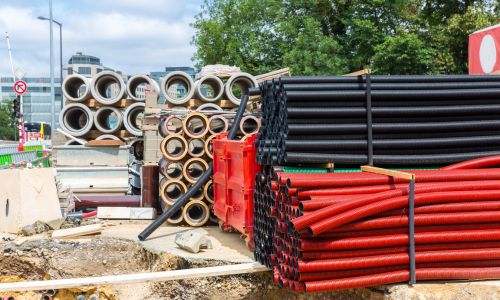Sustainability is no longer a buzzword in the Australian construction industry—it’s a practical necessity. From new residential builds in Melbourne’s inner suburbs to large-scale commercial developments in city centres, the focus is shifting toward smarter, greener building solutions.
One of the most effective ways to reduce the environmental impact of any construction project is through the use of sustainable building materials. These materials not only lower carbon footprints but also support better energy performance, healthier indoor environments, and long-term durability.
Whether you’re building a custom home or planning a modern commercial facility, choosing eco-conscious materials is a vital step toward achieving sustainability goals.
Why Sustainable Building Materials Matter Today
The construction sector is one of the largest contributors to carbon emissions globally and Australia is no exception. Traditional building materials like concrete, steel, and brick require large amounts of energy to produce and transport. These materials also generate significant waste during construction and demolition phases.
As Australia moves towards net-zero emissions, the role of sustainable building practices is becoming more urgent. Eco-friendly materials help reduce energy use, support circular construction, and provide a healthier space for occupants. They can also lead to long-term cost savings through energy efficiency and reduced maintenance.
Beyond regulations and certifications, sustainability is also becoming a deciding factor for homeowners and commercial investors alike, especially those looking to future-proof their buildings.
Key Characteristics of a Sustainable Material
Not all materials marketed as “green” deliver on their promises. A truly sustainable material typically possesses the following characteristics:
-
Low embodied energy: The total energy required for extraction, manufacturing, and delivery is minimal.
-
Recyclability or renewability: Materials can be reused or sourced from renewable resources.
-
Durability: Longer lifespans reduce the need for frequent replacement.
-
Low-toxicity: Materials are safe for indoor use, producing minimal or no off-gassing.
-
Local availability: Reducing transport emissions and supporting local economies.
When selecting materials, these attributes help builders and designers make responsible decisions without compromising on performance or aesthetics.
Top Sustainable Materials Used in Australia
Cross-Laminated Timber (CLT)
CLT is an engineered wood product made by layering timber boards at right angles and bonding them together. It provides excellent structural integrity and is widely recognised as a low-carbon alternative to steel and concrete. CLT is suitable for residential builds and increasingly used in mid-rise commercial construction across Australia. As a renewable material, it’s also aligned with Green Star certification guidelines.
Recycled Steel
Recycled steel retains all the strength of virgin steel but significantly reduces the need for raw resource extraction. It’s commonly used for framing, roofing, and structural supports. Steel is 100% recyclable, meaning it can be reused indefinitely without quality loss, making it ideal for projects focused on long-term sustainability.
Hempcrete
Hempcrete is a bio-composite made from hemp fibres, lime, and water. It is carbon negative, meaning it absorbs more carbon than it emits during production and curing. Hempcrete also offers excellent insulation properties and breathability, making it a strong contender for both sustainable homes and boutique commercial developments.
Rammed Earth
Rammed earth construction uses compacted natural soil to form dense, durable walls. It has a unique aesthetic appeal and high thermal mass, which helps regulate indoor temperatures. It’s particularly popular in rural and coastal areas of Australia where natural material use is prioritised.
Recycled Brick and Concrete
Using recycled materials not only reduces landfill waste but also lessens the need for new material extraction. Recycled brick is ideal for heritage-style residential builds or feature walls in commercial spaces. Crushed concrete is often used for sub-bases, driveways, or structural infill.
Low-VOC Paints and Finishes
Volatile Organic Compounds (VOCs) can cause poor indoor air quality and pose health risks to occupants. Low-VOC paints and finishes are now widely available in Australia and meet indoor air quality standards required for Green Star and NABERS-rated buildings.
Green Insulation Materials
Sustainable insulation options like cellulose (made from recycled paper), sheep’s wool, and even recycled denim offer excellent thermal performance. These materials are safe to handle, low in embodied energy, and ideal for both residential and commercial builds focused on occupant wellbeing.
Sustainable Materials in Commercial vs. Residential Construction
Sustainable principles apply across both residential and commercial projects, but the materials used and selection criteria often differ.
In residential construction, materials are chosen for energy efficiency, comfort, and visual appeal. Homeowners often prioritise healthy materials (non-toxic and low-VOC) and natural finishes that support a passive design approach.
In commercial construction, long-term durability, performance under heavy use, and regulatory compliance take precedence. Materials must meet criteria for fire ratings, acoustic performance, and sustainability certifications like Green Star or WELL.
Despite the differences, many materials—such as recycled steel, low-VOC finishes, and high-performance insulation are shared between sectors.
What to Consider When Choosing Materials for Your Project
Choosing the right sustainable material depends on a range of project-specific factors. Here are key considerations:
-
Climate suitability: Will the material perform well in Melbourne’s varying temperatures and comply with bushfire zone requirements if applicable?
-
Code compliance: Materials must meet Building Code of Australia (BCA) standards and, where applicable, align with local council regulations.
-
Lifecycle costing: Consider not only initial cost but also maintenance, energy performance, and longevity.
-
Material availability: Locally sourced products can reduce delays and emissions.
-
Builder and installer experience: Some eco-materials require specialist knowledge for correct installation.
The Future of Sustainable Materials in Australia
The future of building in Australia is unmistakably green. Emerging technologies are pushing the boundaries of what’s possible, with new materials being developed that go beyond sustainability into regenerative design.
Trends to watch include:
-
Carbon-sequestering concrete alternatives
-
Mycelium (mushroom-based) insulation and panels
-
Circular economy approaches to construction waste
-
Digitally tracked lifecycle data for materials
Government incentives and market demand are driving innovation, making sustainable materials increasingly accessible for mainstream building projects.
Conclusion
Sustainable building materials are more than an industry trend—they’re central to the way homes and commercial buildings are being designed and constructed in Australia today. Choosing the right materials can improve energy performance, occupant health, and environmental outcomes, while also supporting compliance with green building standards.
Whether you’re a homeowner planning a passive design or part of a team delivering a sustainable commercial fit-out, understanding the benefits of eco-friendly materials is key to making responsible and future-ready decisions.
FAQs
1. What are the most sustainable building materials in Australia?
Some of the most widely used sustainable materials in Australia include cross-laminated timber (CLT), hempcrete, recycled steel, low-VOC paints, and green insulation such as cellulose and wool.
2. Are eco-friendly materials suitable for commercial projects?
Yes, many eco materials meet commercial compliance standards and performance requirements. They can also contribute to Green Star or WELL certification goals.
3. How can I verify the sustainability credentials of a material?
Look for independent certifications such as FSC (Forest Stewardship Council) for timber, GECA (Good Environmental Choice Australia), or Environmental Product Declarations (EPDs).
4. Do sustainable materials cost more than traditional ones?
Not always. While some materials have a higher upfront cost, many offer lower lifecycle costs due to energy savings and durability, making them a smart long-term investment.


